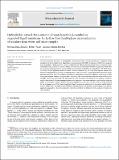Por favor, use este identificador para citar o enlazar a este item:
http://hdl.handle.net/10261/335273COMPARTIR / EXPORTAR:
 SHARE SHARE
 CORE
BASE CORE
BASE
|
|
| Visualizar otros formatos: MARC | Dublin Core | RDF | ORE | MODS | METS | DIDL | DATACITE | |

| Título: | Hydrophobic natural deep eutectic solvents based on L-menthol as supported liquid membrane for hollow fiber liquid-phase microextraction of triazines from water and urine samples |
Autor: | Díaz-Álvarez, Myriam CSIC ORCID; Turiel Trujillo, Esther CSIC ORCID; Martín Esteban, Antonio CSIC ORCID | Palabras clave: | Hydrophobic natural deep eutectic solvent Hollow fiber liquid-phase microextraction L-menthol Triazine herbicides Water samples Urine |
Fecha de publicación: | nov-2023 | Editor: | Elsevier | Citación: | Microchemical Journal 194: 109347 (2023) | Resumen: | This work proposes the use of a hydrophobic natural deep eutectic solvent (NADES) as a supported liquid membrane (SLM) for hollow fiber liquid phase microextraction (HF-LPME) of triazines. NADES were prepared using L-menthol as hydrogen bond acceptor combined with different hydrogen bond donors of natural origin: carboxlylic acids, alcohols and amines. Studies were carried out to determine whether the prepared NADES met the necessary requirements to be used as a SLM, such as stability in the HF and compatibility with HPLC. Then, the ability of each prepared NADES to extract 6 triazine herbicides by HF-LPME from aqueous samples was evaluated. Among them, the mixture L-menthol: formic acid (molar ratio 1:2) provided better extraction results and was selected as SLM. The influence the different parameters on extraction efficiency such as pH of both sample and acceptor solution, salting-out effect, extraction time and stirring rate on the extraction efficiency was carefully studied and optimized. The optimized HF-LPME procedure was applied to the analysis of aqueous samples such as artificial water containing humic acids, tap water, river water and urine, with excellent clean-up ability for all samples analyzed. Relative recoveries ranged from 68 to 128 %, and the LODs and LOQs obtained for the 6 triazines were 0.75–3.1 µg/L and 2.5–10.3 µg/L, respectively, depending on the analyte and the kind of sample. Additionally, according to the AGREEprep tool assessment, the proposed method appears as a greener approach compared to other microextraction methods reported in the literature for the analysis of triazines in water samples. | Versión del editor: | https://doi.org/10.1016/j.microc.2023.109347 | URI: | http://hdl.handle.net/10261/335273 | DOI: | 10.1016/j.microc.2023.109347 | ISSN: | 0026-265X | E-ISSN: | 1095-9149 |
| Aparece en las colecciones: | (INIA) Artículos |
Ficheros en este ítem:
| Fichero | Descripción | Tamaño | Formato | |
|---|---|---|---|---|
| deep-eutectic-solvents.pdf | 2,43 MB | Adobe PDF |  Visualizar/Abrir |
CORE Recommender
SCOPUSTM
Citations
4
checked on 05-may-2024
WEB OF SCIENCETM
Citations
3
checked on 18-feb-2024
Page view(s)
33
checked on 18-may-2024
Download(s)
7
checked on 18-may-2024
Google ScholarTM
Check
Altmetric
Altmetric
Este item está licenciado bajo una Licencia Creative Commons

